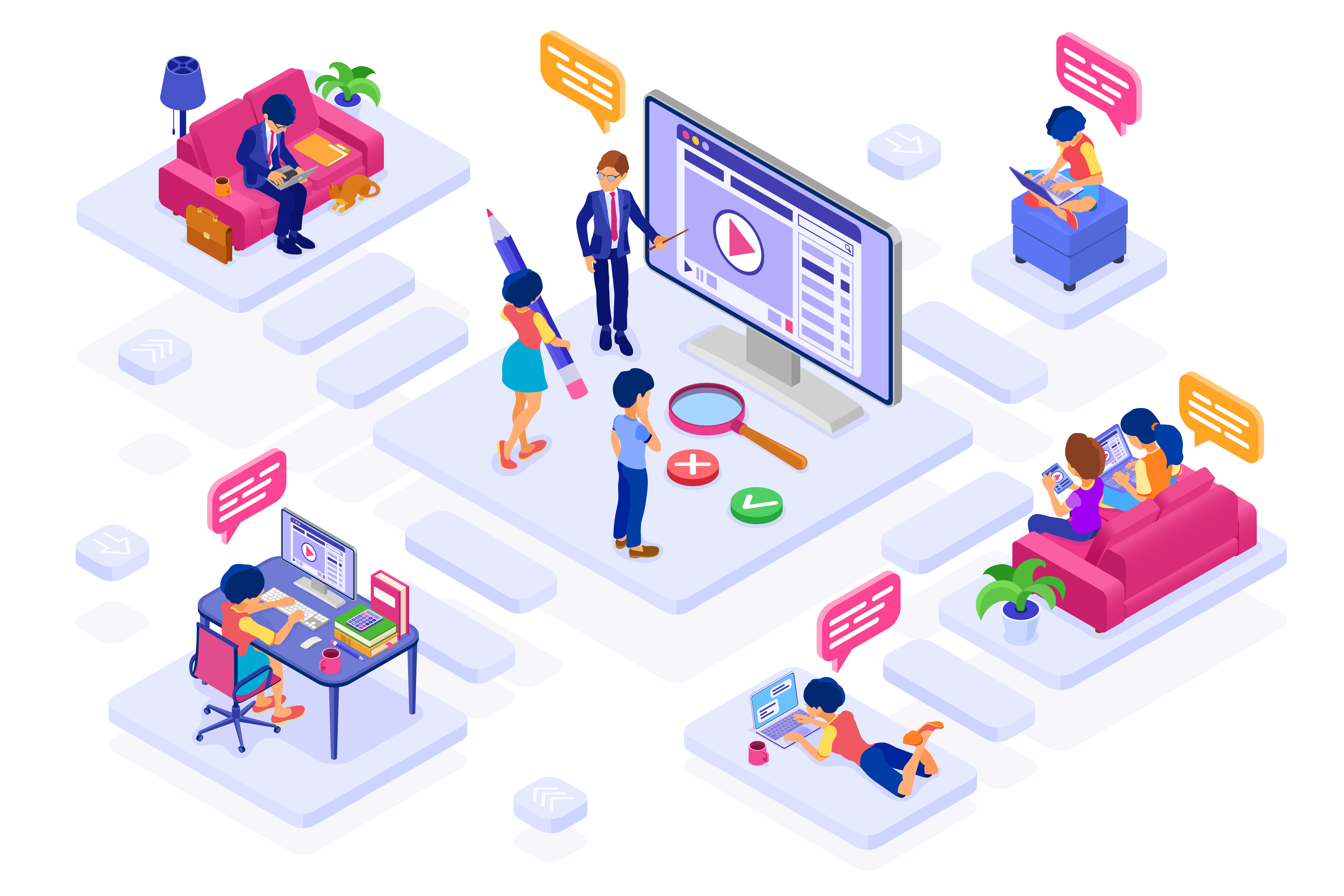2020 has definitely been the harbinger of change. We saw a host of concepts and practices that were on the fringes of acceptance, being catapulted into the mainstream last year. Online proctoring is one such concept. Organizations have been conducting proctored online assessments for quite some time now. In fact, the IT certification council had conducted their first study on remote proctoring to provide guidance to their member organizations in 2016. However, online proctoring or remote proctoring was used sparingly, whenever, and wherever a traditional scheduled exam was not possible. It was the outlier rather than the norm. The social distancing norms imposed by COVID 19 propelled this fledgling concept into adulthood in the space of a few months. So, is online proctoring here to stay, or is it one of those transient concepts that mushroomed in the COVID era, sure to disappear when social distancing is a thing of the past? We think it’s here to stay. According to an Enterprise Technology research survey, the percentage of workers permanently working from home is set to double in 2021. 70% of the workforce will be working remotely by 2025, states a recent Forbes article. It stands to reason that remote hiring will also increase. When remote hiring increases, so will online proctoring. This, coupled with the increased acceptance of e-learning will mean that online proctoring will become a way of life in the coming years. The online exam proctoring market was estimated at $ 354 Million in 2019. It is now estimated to grow to $1 Billion by 2027. Let’s take a look at this path-breaking concept and see how it is set to change the assessment landscape.
What is Online Proctoring?
Online proctoring or remote invigilation as the Brits would call it, is the new age substitute for the stern-faced invigilator who ensured that an exam is conducted fair and square. This form of invigilation recreates the experience of sitting for an exam in a test center under the watchful eye of the invigilator/proctor. Instead of traveling to the exam center to appear for an exam, the remote assessment model allows the candidate to write an exam from any location as long as they have a computer with internet connectivity and a quiet room. This gives flexibility and convenience to both the examinee as well as the examiner. The only catch is in ensuring that all the candidates adhere to the rules of the exam without committing any fraud. This is where online proctoring comes into play. Online proctoring enables the examiner to monitor the candidate during the test with the help of a webcam, mic, and access to the screen of the candidate.
Online proctoring solutions come in many shapes and forms. There are low-security versions that can be easily plugged into an existing LMS and used to proctor medium-stakes exams like a midterm university exam. Then there are the high-security systems that are designed to be integrated with standalone assessment platforms. These are used by certification agencies, recruitment agencies, organizations with their own in-house recruitment tools, and universities for their admissions, placement, or final exams.
A good remote assessment platform will always offer many functionalities that will enhance the overall security and integrity of the assessment. Some such functionalities are lockdown delivery, computerized adaptive testing, randomization, automated item generation, linear-on-the-fly testing, professional item banking, scaled scoring, psychometric analytics, item response theory scoring, equating, etc. In the context of online proctoring, perhaps the most salient is the lockdown delivery. Lockdown delivery enables the online proctoring software to completely take over the candidate’s computer for the duration of the exam. They will not be able to use the computer for anything else during the exam.
Proctors come in many shades
There are many variations of online proctoring.
Live Proctoring using a human proctor – in this format the supervision is done by real people. This means that a real person will authenticate the candidate’s identity, secure the environment and monitor them for the duration of the exam. The presence of a real person is often reassuring for the candidate, as they have someone to ask their questions to and relate to. Live proctoring is often enhanced with the use of technologies like facial recognition, biometric scanning, and scanning behavioral patterns during the exam.
AI-based Live Proctoring – This format of proctoring uses artificial intelligence algorithms to monitor the candidate’s live webcam feed and auto-flag any digressions. This format is fully automated with minimal human intervention.
Recorded Proctoring – In this format, the entire session is not monitored by a proctor. The candidate’s audio, visual and screen-sharing feeds are recorded and reviewed later. The review can be done by people or by using technology. While this format is relatively more economical it does have its share of drawbacks. Any digressions or fraudulent behavior is only caught after the event and hence there is no real-time intervention. So, this mode of online proctoring is normally used in lower-stakes exams.
Get set, Ready, Go, Report: the steps involved
Like any other assessment model, an assessment model with remote proctoring also has its own set of stages or steps.
Get Set: Most remote proctoring platforms run system checks in advance of the assessment. This is to ensure that the candidate’s technical environment is all set to support a remotely proctored exam. In most cases a standard laptop or desktop with internet connection is sufficient.
Are you the real McCoy? The identity of the candidate will be authenticated before the start of the exam.
Ready: The candidate’s immediate environment is reviewed. Care is taken to ensure that the candidate is in a secure and suitable environment, without access to any sources of information that are not permitted.
Go: This is the core of online proctoring. The candidate is monitored during the assessment to ensure there are no infringements of the rules.
Reporting: This is the step where the organization that is conducting the exam or assessment is informed of any infringements.

Is Online Proctoring Your Trump Card?
Remote proctoring has many advantages. It could be that secret trump card in your back pocket that will help you scale while finding the best candidates from around the world. This allows you the advantage of assessing the candidate’s technical skills with your very own customised tests while ensuring that a test centre environment is maintained – all this without the extra hassle of the candidate appearing in person at your office or test centre. Here are some of the advantages of using online proctoring for your assessments.
Scalability: During a traditional assessment process an invigilator can only supervise a fixed number of candidates. Online proctoring enables you to handle a large volume of data points as well as candidates at the same time. If you are on a hiring spree with a target of hiring in the thousands within days, this is the way to go.
Accessibility: When you limit your assessment model to your own test centres you are in fact geographically limiting the candidates that could be assessed. Remote proctoring gives you the advantage of being able to assess candidates from around the world with a minimal change in your processes and infrastructure.
Accuracy: As online proctoring makes use of technologies like behaviour patterns and psychometric analytics this mode of proctoring will be prone to less errors. To err is human, after all!
Validity of claims: Traditional invigilation methods do not keep any records during the assessment. Online proctoring allows for a more stringent approach to the detection and control of fraud. Audio and video recordings, live warnings, and system and browser monitoring are some of the ways in which an online proctoring system prevents fraud. As online proctoring enables the recording of all activities during the assessment it’s very easy to validate a claim of fraud by the proctor.
Logistical ease: Online proctoring does away with the need to find test centres that are easily accessible for candidates. It also makes the entire process of scheduling assessments much easier.
Flexibility: Location and time will no longer be a hindrance with online proctoring. You can assess a candidate from any part of the world.
Cost Effectiveness: This mode of proctoring enables you to assess candidates without investing in testing centres or human proctors. This makes this method much more cost effective if assessments are an integral part of your business model and have to be done on a large scale.
This form of proctoring also has its share of disadvantages. As this is a new form of assessment, some candidates could be overwhelmed by the technology. This would hinder your quest to find the best candidates. Candidates could also have privacy concerns because of the constant video feed and the computer system lockdown. It is important to acclimatise the candidate with your privacy protection policy well in advance. You could also alleviate the candidate’s concerns about using this form of assessment by sharing more information about the process well in advance.
The crystal ball says AI
It makes perfect sense to use AI in online proctoring. We have seen an increase in the use of AI in the past few years and it is set to be more in the future. AI currently enhances the entire online proctoring experience through voice recognition, facial recognition, pattern recognition, eye movement recognition, and object recognition. It is expected that AI algorithms used to detect fraud will improve as the system learns. We are not very far off from a future when all assessments are conducted with AI-assisted remote proctoring.
If you are thinking of using remote proctoring for your hiring needs, it’s always best to be armed with as much information as possible before you try a new concept. Check out HirePro’s proctoring solution. You could also call us at 080 6656 6000 or write to us at sales@hirepro.in for a demo.
Good Hiring!
References:
–https://blog.mettl.com/online-web-proctored-exams/
–lebow.drexel.edu
–insidehighered.com
–Magic EdTech
–AWS Training and Certification Blog
–digiproctor
–Forbes







